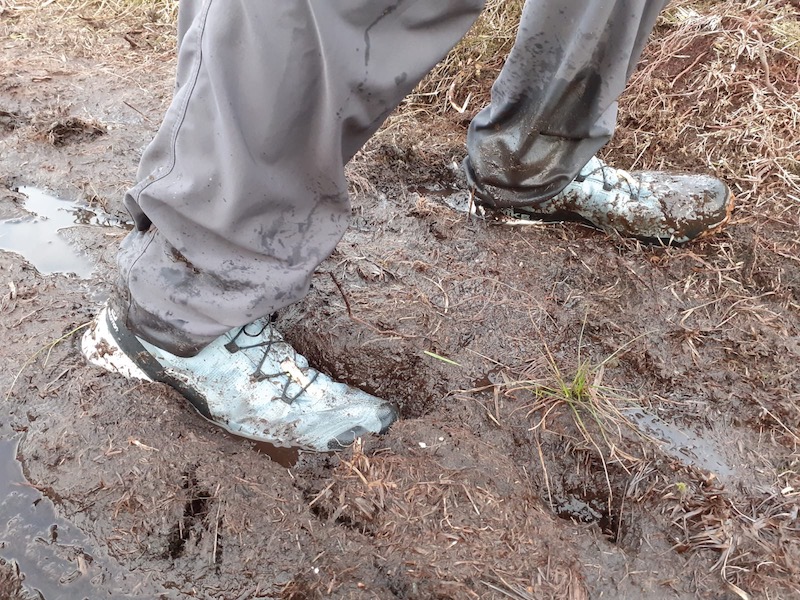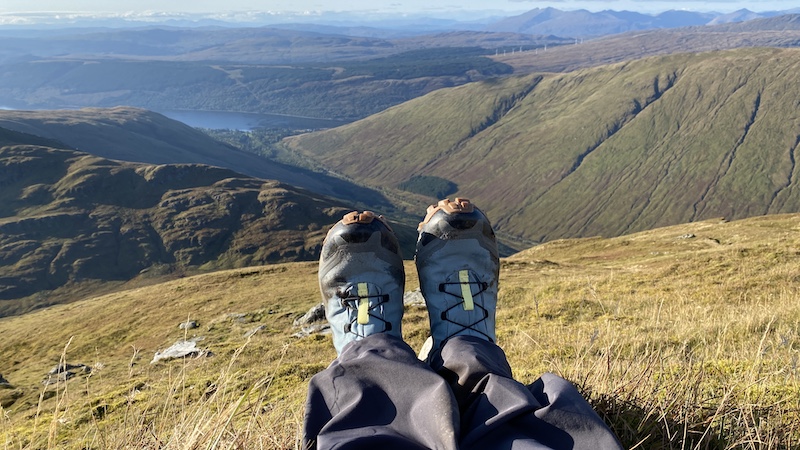This is my review of the new Salomon Crosshike Mid GTX walking boots. I have spotted a growing number of boots on the market that are a cross between a running shoe and a walking boot. For example, Adidas has a Terrex Free Hiker and inov-8 has launched the ROCLITE PRO G 400 GTX boot. Salomon’s new hybrid walk-run boot is the Crosshike Mid GTX.

Features of Salomon Crosshike Mid GTX:
- Quicklace: “Minimalistic and strong lace for one-pull tightening”
- Gore-Tex waterproof membrane
- Synthetic upper
- Water repellent treatment
- Seamless, closed-mesh construction
- Anti-debris mesh
- Rubber stone guard
- Contragrip outsole
- Chevron lugs for great traction on soft surfaces, such as mud or loose dirt
- “Optimised” heel grip
- EnergyCell+ – a high-rebound midsole compound
- Drop: 10mm
- Weight: 396g per boot
- Male & female fit
- RRP: £165.
- See Salomon.
The Salomon Crosshike boots are described by the brand as “agile yet really grippy”.

On test: Salomon Crosshike Mid GTX boots
This summer, I have mostly been wearing Salomon Speedcross running shoes. I like the fit and the lightweight feel of shoes, as well the feel of the ground under my feet. However, the shoes do not give ankle support and as we head into the wetter and muddier weather of autumn and winter, I am aware I’ll need to wear a boot again.
A boot offers greater ankle support in unpredictable terrain and also provides greater protection from the rain and wet underfoot.
It is quite a jump for me to wear heavier and more rigid boots so the idea of a boot that is a cross between a running shoe and a walking boot really appeals.
I really like how comfortable and light the boots are. As soon as I put them on, they felt great. I had to tighten the lacing system quite a lot to get a neat and secure fit because I have long and narrow feet.
In fact, the volume depth was still too big and I decided to change the insole for another one that is a bit thicker. This gave me a much better fit. I felt the boots do have a larger volume depth than other Salomon foot wear.
The one-pull lace system is often used by Salomon and it has advantages and disadvantages. It’s easy to get an even tension across the boot with this one-pull lace. However, while the lacing might seem firm to start with, they do loosen. I had to stop to sort the lacing while walking.

Because I have a narrow foot I need to pull the laces tight to get a good fit and this leaves a lot of lace to tuck into the tongue pocket. The tongue pocket is big enough to accommodate all the excess lace but you do need to make sure it is all tucked away so that it doesn’t start to unravel as you walk. I think, on balance, I prefer ordinary laces.
The boot is very easy to walk in and has good cushioning, as well as a trainer like comfort underfoot. I can’t say I notice the EnergyCell+ specifically but I did find the boots comfortable to wear for many hours and on a range of terrain.
I walked through mud, over wet rocks and trails, down soft grass and through a river. In all situations I felt fairly confident that the boots would give good grip.

The wide lug channels also meant the mud and dirt could easily disperse and each time I looked at the base of the boots, they were free of muck. This is good because it means the lugs are free to do their job of being grippy.
The soles are great for a range of terrain and for both wet and dry conditions. I also like the extra grip on the toe-cap end of the sole
While the soles and rand seem fairly durable I am not sure how long they will last in Scotland’s rocky and rough mountain terrain. The wide rand around the boot is made of a durable looking rubber material but Scottish mountains can be very hard on footwear.
Time will tell but I do think they are probably better suited to grassy hills and less rocky paths and trails. Still, I’ll be wearing them in the Scottish mountains and I will report back in due course as to how they cope.
The ankle support is better than a trainer but, of course, not as good as a full height boot. After wearing a running shoe all summer, the ankle support felt amazing to me.

I like the mid height but if you are looking for a solid ankle support, the mid height is not the solution. I do think it would be better if you could tighten the ankle a bit more. Perhaps the boots need another set of eyelets to give greater support but, personally, I like the fit and feel of the ankle part of the boots.
The boots are new and so you would expect waterproofing to be good. It is. I walked through a fast-flowing river, puddles and wet mud. I felt no water seepage through the boot.
As well as Gore-Tex membrane, there is a water repellent treatment to the synthetic upper. The treatment will inevitably wear off with abrasion but the Gore-Tex should still offer good waterproofing.
The boots do look quite funky although I am not so sure about the choice of colour of the pair that I was sent to test. They have a light green upper and white soles. This colour will only end up dirty and grey and it might be better to choose a darker colour in the first place.
The other colour for women is black, while the men’s boots come in black, dark grey or red. Why do women not have a choice of three colourways, I wonder?
The boots RRP at £165, which seems competitive. Many people spend well over £120 for a pair of trail running shoes, so £165 seems fair enough for boots.
I think these will be a great boot for wearing most of the year. In winter, especially in the mountains, you will probably want a boot with more insulation and a more rigid sole. These boots won’t be suitable for many types of crampons, for example.
Many people now enjoy faster walking and walk-running in the hills and mountains and these boots do appear to be offer a good hybrid of running shoes and more traditional walking boots.
Conclusion: I have been thinking about whether these hybrid shoes-boots are a good compromise. They are not the best walking boots I have ever tested and nor are they the best footwear for trail running. But if you like the idea of fast-hiking, mixed with bit of running where terrain and conditions allow, I think they are a great idea because they are as comfortable – well almost – as running shoes but offer much more stability, durability and weather-proofing.
Given that I have walked many mountains this summer in running trainers, I can see myself choosing the Salomon Crosshike Mid GTX walking boots for hikes in autumn and many days of winter. In all but the most wintry and icy of conditions, these trainer style boots will serve me well. I don’t mind a less supportive ankle, unless I am on very tricky and unpredictable terrain and I really like the comfort and weight of the boots.

